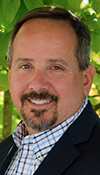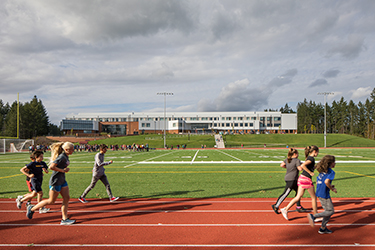|
Subscribe / Renew |
|
|
Contact Us |
|
| ► Subscribe to our Free Weekly Newsletter | |
| home | Welcome, sign in or click here to subscribe. | login |
Construction
| |
 |
October 6, 2022
The next great environment for schools
Skanska

Urban
|
From the first day of kindergarten pics on social media to high school football highlights on TV to groundbreaking research being done at colleges and universities across the Northwest, schools are on our minds and in the news almost daily. It’s no wonder, because whether or not we have kids of our own, schools are often at the center of our local communities. As such, one thing I hope we can all agree on is that it’s important that kids of all ages have a great environment in which to learn and grow.
But what exactly does great environment mean and how does that impact what we do at Skanska?
To explore this, we gathered a team of executives from several offices across the nation to discuss trends we’re seeing in both K-12 and higher-ed school design and construction.
These are some of our key takeaways:
CLIMATE GOALS
Many colleges and universities are aiming to be carbon neutral in the next few years. They have developed strategic plans to transition to all electric buildings and central plants, improve energy efficiency, develop on-site renewables, among other efforts. As they begin assessing their needs for new facilities, sustainable solutions are becoming a central theme of smart, well-crafted design.
Nationally, K-12 school districts are focused on reducing energy consumption and cost through maintenance improvements and assessing new projects through energy life-cycle cost analysis. Most states require minimum standards to qualify for funding — in some cases similar to LEED certification. Some mandates go further, such as in the Pacific Northwest, where there are a number of ways to meet the Washington State Energy Code requirements such as installing solar power or developing all-electric buildings to eliminate the need for natural gas.
While the current focus is on operational efficiency, there is growing interest in lowering embodied carbon, too. Our teams have helped K-12 customers identify sustainable building materials in preconstruction to reduce their projects’ overall carbon footprint with the Embodied Carbon Calculator for Construction (EC3). Co-developed by Skanska and the Carbon Leadership Forum, EC3 tracks embodied carbon data for construction materials like concrete, rebar and steel, allowing customers to compare proposed materials and make choices that meet their carbon goals with minimal cost or schedule impact.
SPACE FLEXIBILITY
The need for flexible spaces is becoming a big factor for many school districts. For schools that need increased capacity for certain grades — say, for eighth and ninth grades — we are seeing buildings designed to initially accommodate the larger student body, that can then be converted to fit their next need.
Some school districts are finding value in developing prototype designs, a technique that provides cost and schedule efficiencies through their repetitive nature. For these projects, the design team, construction manager and subcontractors collaborate on multiple projects across a single school district to deliver buildings that are largely identical yet can be tailored to the aesthetics of each school. The projects’ “kit of parts” can include the structural system, mechanical, electrical, and plumbing systems. Not only is this cost effective, it’s also hugely beneficial for the schedule.
WELL-BEING
The impact of design on mental health is starting to be factored into decisions on how buildings are designed, how they’re used, and even where they’re located.
One trend we’re seeing in K-12 is trauma-informed design options with private (but supervised) breakrooms where kids can decompress when they’re feeling stressed.
We’re also seeing a trend of incorporating the outdoors into the learning process through the inclusion of outdoor auditoriums/classroom settings and with outdoor learning areas. Nurse logs, native plants, greenhouses and sensory gardens are the most common outdoor elements school districts are requesting.
On one of our Montessori schools, a connection to the natural environment is part of the identity of the school, so the project includes a garden and staging area for students to set their gardening gear (rubber boots and jacket) to dry after cleaning. Similarly, for two local high school projects, we incorporated outdoor gathering spaces, including gardens and auditorium areas for teachers to take classes outside.
BUILDING SECURITY
Across the country, school districts are prioritizing the security of their K-12 buildings to ensure the safety of students and staff. Increased public demand for heightened safety measures is driving the type of funding schools seek.
A common design choice we’re seeing is establishing a more secure school through implementing a single point of entrance that distributes students and staff through buildings or better secured outdoor areas. The change in design also often employs a secure vestibule where administrators have to grant visitors access into the building during the school day.
Our customers are focusing on security systems with reliable communications and increased lockdown capabilities. For dependable and easy communication with first responders, school districts are installing or upgrading distributing antenna systems (DAS). Exterior identification, like large classroom numbers, are being added to exterior walls and roofs for quick identification by the police or fire department. Additional measures include security cameras, card reader door locks, blackout glass for single-way visibility, and ballistic-resistant glass in select areas.
IMPORTANCE OF ACOUSTICS
Acoustical treatment in schools has been commonplace for some time, whether to amplify sound for theaters or reduce noise in the industrial arts classrooms (a.k.a. shop class). Sometimes, entire schools require an extra level of acoustical attention due to their surrounding environment.
One of our high school projects, for example, was located a few miles from one of the runways at Sea-Tac Airport. The district wanted to ensure that students, faculty and staff had the best environment, so a grant was secured from the FAA to cover the cost of acoustical elements to dampen aircraft noise. Skanska helped the school district evaluate components and materials that would affect acoustics.
COMMUNITY MEMBERS’ ROLE
Universities are establishing committees as part of their governance structure to advise on how buildings will be designed, built, and used. These committees are often made up of community members, leaders of neighborhood groups, former students, local tribal members, and other stakeholders.
At the K-12 level, since many school construction projects are funded through tax levies, the voices of community members are often as important as the teachers and administrators. The goal is to ensure that all input is considered and that concerns are addressed before shovels hit the ground.
Just as our kids grow and their needs change, so too with the needs of our local communities, schools and school districts. As trusted partners, it’s imperative that we remain ahead of the latest trends and help guide our client partners as they work to create the next “great environment” where our young people can learn and grow.
In his role as vice president at Skanska, Brian Urban provides leadership for the company’s K-12 practice, which represents more than $750 million of community-focused projects in the Puget Sound area.
Other Stories:
- Design can influence beyond its borders
- K-12 alternative delivery is here to stay
- Teamwork creates modern, flexible spaces to learn
- Here’s how to decrease carbon emissions in schools
- Feasibility and design in early learning education
- Designing a co-location campus
- Centering community for a transformational result
- Building resiliency at University of Washington



